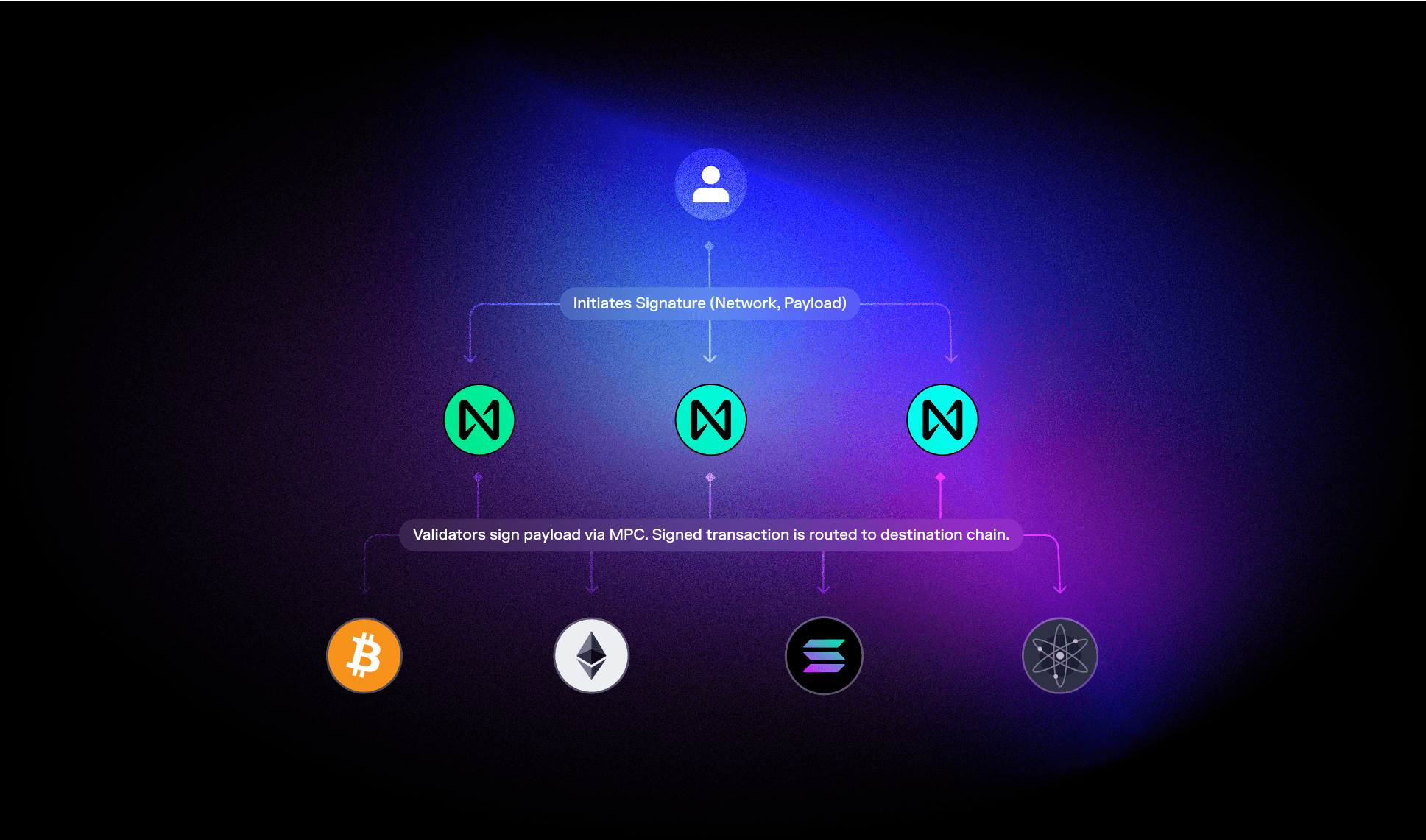Bitcoin's New Horizon: Leveraging NEAR's Chain Signatures for Enhanced Interoperability
Oct 12, 2024
The blockchain ecosystem has long grappled with a critical challenge: interoperability. Bitcoin, as the first and most renowned cryptocurrency, has remained largely isolated from the innovations flourishing on other blockchains. NEAR's introduction of Chain Signatures represents not just a technical evolution but a strategic pivot towards a unified blockchain future. Here's an in-depth exploration into why this technology is pivotal.
• • •
The Siloed Nature of Bitcoin
Bitcoin's architecture, while secure and decentralized, wasn't designed with interoperability in mind. This has led to a scenario where Bitcoin, despite its market dominance, cannot directly leverage or contribute to the rapid advancements in blockchain technology, particularly in areas like DeFi, where assets are exchanged across chains. The need for Bitcoin to interact with these systems isn't just for convenience sake; it's essential for its continued relevance.
NEAR’s Chain Signatures: A Technical Overview
Chain Signatures function as a cryptographic handshake between blockchains. Here's how they revolutionize blockchain interaction:
Cryptographic Integrity: At the heart of Chain Signatures is an advanced cryptographic protocol, leveraging the threshold signature scheme, that allows users and smart contracts to create addresses and signatures for any number of blockchains. This is achieved through a series of cryptographic proofs produced on a secure, decentralized MPC network.
Decentralized Verification: Unlike traditional solutions that might rely on centralized components or third-party services, Chain Signatures ensure that trust is maintained through decentralized MPC networks. This reduces points of failure and potential vulnerabilities.
Better Interoperability: Using Chain Signature accounts as individual user lockups for Bitcoin, or other assets used in cross-chain DeFi, eliminates a number of infrastructure risks commonly associated with bridging such as holding all bridged assets in a single address.
Scalability and Speed: By running the application logic on other chains or with off-chain solutions before final settlement on the Bitcoin mainnet Chain Signatures can address Bitcoin's scalability issues indirectly by leveraging the capabilities of faster, more scalable chains, such as NEAR, and their smart contract capabilities.

Strategic Use Cases Enhanced by Chain Signatures
1. Bitcoin in DeFi: The DeFi sector has grown exponentially, yet Bitcoin's role has been minimal due to its lack of native support for complex smart contracts. With Chain Signatures, Bitcoin can be deposited to a derived address and locked according to the rules of a protocol. This Bitcoin can then be tokenized on other platforms, enabling its use as collateral in lending protocols, yield farming, or even as a direct trading pair in decentralized exchanges (DEXs). All without the need for centralized custodians.
2. Seamless Asset Portability: The ability to move Bitcoin across chains means that users can take advantage of different blockchain features. For example, Bitcoin could be used on a chain with high transaction throughput for retail purposes.
3. Smart Contract Integration: Bitcoin could trigger or be part of complex smart contract workflows on other chains. Imagine a scenario where a Bitcoin transaction automatically executes a series of actions on the NEAR or Ethereum blockchain, like conditional payments or automated trading strategies. For example, one can transfer Bitcoin to a Chain Signatures address that automatically kicks off streaming payments or automated trading strategies.
4. Chain Abstraction: For end-users, this means interacting with other blockchains could become as simple as using their Bitcoin wallet. Dapps and protocols using Chain Signatures are able to abstract away underlying blockchain specifics. This could dramatically lower the entry barrier to DeFi for new users, capital, and enterprise adoption.
The Imperative for NEAR’s Chain Signatures
The push towards interoperability through Chain Signatures isn't merely about enhancing user convenience. It addresses fundamental economic and technological imperatives:
Market Liquidity: By allowing Bitcoin to flow freely between ecosystems, liquidity across the entire blockchain space increases, potentially stabilizing Bitcoin's price volatility and increasing its utility.
Innovation Fusion: Different blockchain projects have specialized in various niches. Interoperability means these innovations can be combined in ways previously unimaginable, possibly leading to new economic models, governance systems, or even consensus mechanisms.
Security and Trust: While bringing chains together, Chain Signatures also upholds the security principles of each involved blockchain, ensuring that interoperability does not come at the cost of security.
The Road Ahead: Transformative Implications
The adoption of NEAR's Chain Signatures technology represents more than an incremental improvement in blockchain infrastructure—it can mark the beginning of a fundamental shift in how distributed systems interact. What began as a technical curiosity among blockchain developers has the potential to evolve into a cornerstone of Web3 architecture, much like how TCP/IP protocols transformed from academic interest to the backbone of modern internet communications.
Beyond Bitcoin Versatility
While enhancing Bitcoin's capabilities is a crucial outcome, Chain Signatures' implications reach far deeper into the blockchain ecosystem:
• Standardization of Cross-Chain Communication: Chain Signatures establish a precedent for secure, efficient blockchain interaction protocols. This standardization could do for blockchain what HTTP did for web communications—create a universal language for cross-chain operations.
• Evolutionary Pressure: As Chain Signatures gain adoption, they can create evolutionary pressure on other blockchain projects to embrace interoperability. Networks that remain isolated risk becoming technological islands in an increasingly connected crypto landscape.
• Economic Network Effects: The ability for assets and data to flow freely between chains creates powerful network effects, potentially leading to exponential growth in cross-chain applications and services.
Maturation and Innovation
As Chain Signatures technology matures, we can anticipate several key developments:
1. Cross-Chain Applications:
Emergence of "chain-agnostic" DeFi protocols that automatically route transactions through the most efficient paths
Completely decentralized infrastructures (elimination of centralized bridges and relayers, replaced by trustless cross-chain communication protocols and distributed validator networks)
Development of sophisticated arbitrage mechanisms that maintain price equilibrium across multiple chains
Creation of new financial instruments that leverage the unique properties of multiple blockchains simultaneously
2. Integrated Financial Ecosystem:
Seamless movement of assets across chains without user intervention
Unified liquidity pools that span multiple blockchains
Advanced risk management tools that leverage cross-chain diversification
Real-time settlement systems that optimize for both security and speed
3. Governance and Coordination:
Cross-chain governance mechanisms that enable coordinated protocol upgrades
Interchain security measures that allow smaller chains to leverage Bitcoin's security model
Collaborative spam prevention and attack mitigation strategies
The Vision of a Decentralized Global Economy
The ultimate promise of Chain Signatures extends beyond technical innovation—it's about realizing the vision of a truly decentralized global economy. In this future:
• Bitcoin as a Central Pillar: Rather than existing in isolation, Bitcoin serves as a foundational element of a highly integrated crypto ecosystem. Its role evolves from purely digital gold to an active participant in complex financial operations across multiple chains.
• Democratized Access: Chain Signatures enable users from any blockchain ecosystem to interact with Bitcoin and other assets without needing to understand the underlying technical complexities.
• Economic Efficiency: The free flow of assets and information between chains creates more efficient markets, reduces friction, and unlocks new forms of value creation.
• Innovation Acceleration: The ability to combine features from different blockchains accelerates innovation, allowing developers to build increasingly sophisticated applications that weren't possible in siloed environments.
Looking Beyond the Horizon
As we peer into the future, NEAR’s Chain Signatures provides a glimpse of blockchain's next evolutionary leap. One can envision the technology's adoption following an S-curve: initial skepticism, followed by gradual adoption among early innovators, leading to rapid mainstream integration as benefits become apparent.
This transition won't happen overnight, but its trajectory is clear. Just as the internet evolved from disconnected networks into today's seamlessly integrated global system, blockchain technology is poised for a similar transformation. Chain Signatures represent a crucial step in this evolution, laying the groundwork for a future where digital assets and information flow freely across chains, creating a more efficient, accessible, and truly decentralized global economy.
The question is no longer whether such integration will happen, but how quickly we can overcome the technical and adoption challenges to realize this vision. As Chain Signatures mature and evolve, they could become an instrumental force in shaping the next chapter of blockchain technology's remarkable journey.
Getting Started with Chain Signatures
Ready to build? Here is a list of resources for founders, developers and blockchain professionals interested in building with Chain Signatures:
Core Resources
Chain Signatures Documentation: Implementation guides for cross-chain interactions
NEAR Protocol Documentation: Complete technical documentation and development guides
GitHub Repository: Open-source code and development examples
Community & Events
Developer Community: Join the chain Abstraction discussions on Telegram
NEAR Events: Participate in workshops, hackathons, and conferences
Begin your development journey by exploring the documentation and connecting with our community through these official channels.
• • •
Disclosure: Proximity Labs holds $NEAR and other tokens or investments that may be associated with protocols or projects mentioned in this article. These statements are intended to disclose any conflict of interest and the content of this article should not be misconstrued as a recommendation to purchase or sell any token or to use any protocol. This article also contains forward-looking statements about third-party projects that the authors have no control over and, as such, actual future developments may be substantially different from the expectations described in the forward-looking statements for a number of reasons, including those that are not under the control of the authors. The content of this article reflects the opinions of its authors and is presented for informational purposes only. This is not and should not be construed to be investment advice.
Back to Research
